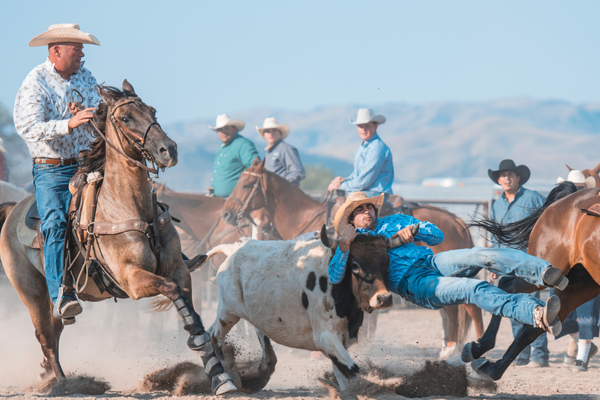
I don’t think my mom played football, but she thought she knew how to take down a ball carrier. “Hit them low! Take out their legs.” This was her solution to arm tackling up high where the defender grabs on around the shoulder pads and goes for a ride – like a weakling trying to take down a steer. Bulldoggin, I think it’s called. Why would you bulldog rather than say, use a lariat? Boys will be boys, I suppose. Come to think of it – I don’t think bull riding accomplished anything useful down on the ranch either.

I can’t say that I was following mom’s orders in seventh or eighth grade, but I made a game-saving tackle on a bruising 180-pound runner when I took out his legs. See ma! Except it was his knee in full gallop straight ahead and my unprotected ribs. I was winded and couldn’t breathe for five minutes, I swear. I lay on my back as our coach, a former hulking college football lineman, practically lifted me off the ground by my belt. Is this appropriate treatment, doc? According to this site, precisely the opposite – sit in a crouched position to let the muscles relax to enable breathing more quickly.
Go to the doctor? No. We didn’t go to the doctor unless a limb bent where it shouldn’t, bleeding wouldn’t stop, or the pain made us cry several hours after injury. One time I got my clock cleaned helmet to helmet. I experienced a burst of light and got up a little disoriented – a likely concussion, which probably explains some things.
Blocking and Tackling
I thought of blocking and tackling before sharing some childhood football escapades. Also known as the basics, it is what many efficiency programs need, at least for the large commercial and industrial segments. Commercial subsectors include commercial real estate, k-12, higher ed, government (all levels), and healthcare – the facilities that are most likely to be around for a long time, unlike, say, Bed Bath and Beyond.
I jotted down the topic of this post as I listened to a conversation in which the program administrator, in this case, a utility, had a high priority for long-lived measures – projects of a type that are expected to generate savings for many years – like 15 or more.
Long Term
Like most successful endeavors in life, success requires resilience over a long-term grind – college degrees, sports, and a career.
The kudzu of efficiency that is lighting is about to be exterminated (thankfully). My assessment of the implementation contractor (IC) market is that it is trying to cram other technologies into the lighting model, and that’s simply not going to work. Long-lived measures require long-range planning with a full spectrum of energy efficiency, from operational and behavioral measures to major capital projects. I wrote this back in 2016, and the Northeast Energy Efficiency Partnerships cooped it to my glee. They quoted one of my posts concerning Strategic Energy Management, or SEM:

SEM is too often, if not almost always, focused on low-cost operational measures that capture savings immediately. That’s wonderful, but administrators cannot afford to stop there. SEM puts the IC in the building, looking at everything, talking to the right people, presumably from the head of maintenance, plant manager, bean counter, and the people who don’t wear jeans.
Downrange
As I mentioned last week, ICs need to look downrange: next year, the year after, and the next three years, out to year five at least. SEM customers should rarely participate in prescriptive, midstream, or upstream programs representing mini savings from a marginal increase in efficiency. Instead, with their IC lead, they should be standing back, looking at the big picture, including plans for growth, changing production, the ability to adapt to frequently changing product lines and volumes, and so on.
Nearly every time a significant piece of equipment is replaced – chiller, air compressor, refrigeration compressor, heat rejection equipment, or boilers – there is much greater potential for improvement by providing flexibility with the design, fuel switching, or changing a process altogether, such as induction heating rather than convection heating materials. Implementation contractors must present these ideas long before the blowtorches and pipefitters arrive. And always fix the problem rather than address symptoms.
Document and Demonstrate
Want another good idea? Keep a log of the impacts the customer is achieving. The name of the game is to shift operating costs from wasted energy and productivity to capital measures and savings that flow straight to the bottom line. This way, the short payback and high ROI cash flows can be plowed into those capital projects later while keeping the bean counter tranquil.
Long-lived projects that capture savings for 15 years or more require long-range planning. It requires a long-term relationship, documentation, and results demonstration because people come and go.
Case in Point
Want an example? Michaels began working with Luther College in Decorah, IA, about 20 years ago, and together, we followed the above pattern with a long string of major and lesser projects – a new campus-wide building automation system, retro-commissioning, behavioral engagements with students, and dozens of planned deep retrofit projects and new construction projects. They stand at a 64% reduction in CO2 emissions so far. How many large energy users can prove that?
